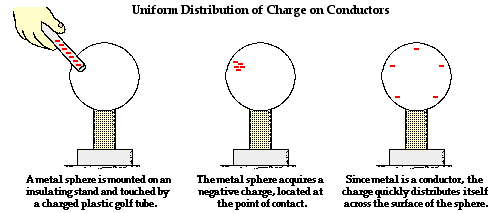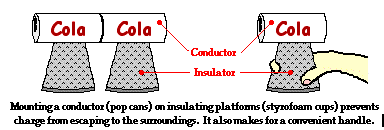CONDUCTORS AND INSULATORS
Electricity of Class 9
The force between two charges is directly proportional to the product of two charges q1,q2 and inversely proportional to the square of distance (r) between them
 , where K is constant of proportionality.
, where K is constant of proportionality.
- Electric charges can neither be destroyed nor be created.
- (Charges are additive i.e. total charge is the algebraic sum of the individual charges.
Coulomb’s law says that force of attraction between two charged particles includes when distance between both the charges decreases and both the charge value include force will increase
PROPERTIES OF ELECTRIC CHARGE
The unit of electric charge is coulomb and 1 coulomb is the charge contained in 6 × 10–18 electrons. Unlike (opposite) charges attract each and like (similar) charges repel each other. A law stating that like charges repels and opposite charges attract, with a force proportional to the product of the charges and inversely proportional to the square of the distance between them.
CONDUCTORS AND INSULATORS
CONDUCTORS:
The behavior of an object that has been charged is dependent upon whether the object is made of a conductive or a nonconductive material. Conductors are materials that allow electrons to flow freely from atom to atom and molecule to molecule. An object made of a conducting material will permit charge to be transferred across the entire surface of the object. If charge is transferred to the object at a given location, that charge is quickly distributed across the entire surface of the object. The distribution of charge is the result of electron movement. Since conductors allow for electrons to be transported from particle to particle, a charged object will always distribute its charge until the overall repulsive forces between excess electrons is minimized. If a charged conductor is touched to another object, the conductor can even transfer its charge to that object. The transfer of charge between objects occurs more readily if the second object is made of a conducting material. Conductors allow for charge transfer through the free movement of electrons.
All the metals like silver, copper and aluminium etc., are conductors. Carbon, in the form of graphite, is a conductor and the aqueous solutions (water solutions) of salts are also conductors. The human body is a fairly good conductor. All the conductors (like metals) have some electrons which are loosely held by the nucleus of their atoms. These electrons are called "free electrons" and can move from one atom to another atom throughout the conductor. The presence of "free electrons" in a substance makes it a conductor of electricity.

INSULATORS:
Substances through which electric charges cannot flow, are called insulators. In other words, those substances through which electricity cannot flow, are called insulators. Glass, ebonite, rubber, most of the plastics, paper, dry wood„ cotton, mica, bakelite, and dry air, are all insulators because they do not allow electric charges (or electricity) to flow through them. In the case of charged insulators like glass, ebonite etc., The electrons present in insulators are strongly held by the nuclei of their atoms. Since there are "no free electron" in an insulator which can move from one atom to another, so an insulator does not allow electric charges (or electricity) to flow through it.
Insulators are materials that impede the free flow of electrons from atom to atom and molecule to molecule. If charge is transferred to an insulator at a given location, the excess charge will remain at the initial location of charging. The particles of the insulator do not permit the free flow of electrons; subsequently charge is seldom distributed evenly across the surface of an insulator.
While insulators are not useful for transferring charge, they do serve a critical role in electrostatic experiments and demonstrations. Conductive objects are often mounted upon insulating objects. This arrangement of a conductor on top of an insulator prevents charge from being transferred from the conductive object to its surroundings. The insulator serves as a handle for moving the conductor around on top of a lab table. If charging experiments are performed with aluminum pop cans, then the cans should be mounted on top of Styrofoam cups. The cups serve as insulators, preventing the pop cans from discharging their charge. The cups also serve as handles when it becomes necessary to move the cans around on the table.

SEMICONDUCTORS:
Those substances whose conductivity lies in between that of the conductors and insulators are called semi-conductors.
For eg : Silicon, germanium are semi-conductors.

We have already learnt about flow of charges that produce electricity.
- ELECTRICITY
- CONDUCTORS AND INSULATORS
- ELECTRIC CIRCUIT AND ITS COMPONENTS
- EARTHING
- ELECTRIC CHARGE
- PROPERTIES OF ELECTRIC CHARGE
- ELECTRIC CURRENT
- ELECTRIC FIELD AND ELECTRIC POTENTIAL
- OHM’s LAW
- COMBINATION OF RESISTORS
- Solved questions
- Exercise 1
- Exercise 2
- Exercise 3
- Exercise 4 (True and False)
- Exercise 5 (Subjective)









